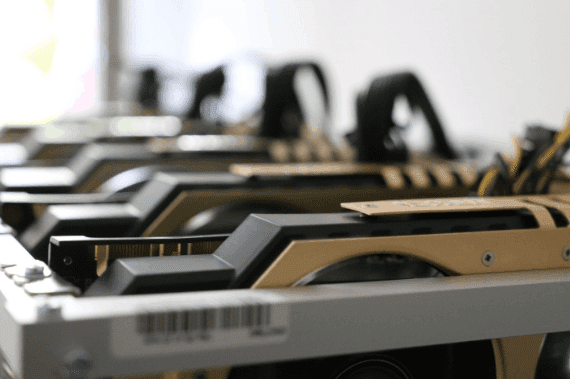In this issue
- Bitcoin proves too magical for Harry Potter’s creator
- Ukraine pilots CBCD using Stellar
- Investors allege Nvidia misrepresented over $1 billion in crypto sales
- In China: blockchain jobs gain new respectability, and more fintech hothousing for Hong Kong-Guangdong Greater Bay Area
- VC highlights in Singapore and South Korea
From the Editor’s Desk
Dear Reader,
From the wizarding world of Harry Potter… to the perplexing world of cryptocurrency. Two worlds collide in one Twitter storm between J.K. Rowling and some key blockchain / cryptocurrency notables and advocates including Vitalik Buterin, Elon Musk and others. The Venn diagram of influence, government, leaders and blockchain is starting to grow as governments increase regulation and shape policy, while multinationals implement blockchain as part of digital transformation. In China, it is increasingly becoming a moot point. This week, China has only strengthened the blockchain talent supply chain by adding two blockchain-related occupations to its official “People’s Republic of China Classification of Occupations” list. A nod by central planning for parents to encourage their children and others into the magical world of blockchain coding, which will be supported by government policy and funding — stripping away any doubt this would be a socially-admired role for any top citizen.
One thing that’s clear to us at Forkast.News is that technology isn’t just a story about innovation, but also its impact on business, the economy, geopolitics and society. Cryptocurrency and blockchain, as they collide with AI, IoT, 5G, cloud and more is where the real growth is, accelerated by post-Covid sensibilities. This week’s top trending stories only affirm the pace of growth.
The Current Forkast this week remains sunny in this blockchain hothouse. Interest from Harry Potter’s creator, with an estimated personal fortune of $1 billion USD, might reveal how high-net-worth individuals may be starting to consider bitcoin. With more and more institutional investors and traditional money managers like Paul Tudor Jones snatching up bitcoin as a hedge against inflation, advisors for J.K. Rowling and others of her socio-economic ilk may be introducing a similar strategy to their clients: buy bitcoin. With the world in the grips of a Voldemort-like curse, cryptocurrencies like bitcoin might be just the thing for us Muggles to fight a future enemy in a grand battle to come: stagflation.
Until the next time,
Angie Lau,
Founder and Editor-in-Chief
1. BTC proves too magical for J.K. Rowling

By the numbers: J.K. Rowling — over 5,000% increase in Google search volume.
Bitcoin is thrown into the limelight again just a week after its halving. Creator of the wizarding world of the Harry Potter series J.K Rowling seems to have had one Old Fashioned too many over the weekend. The famed author took to Twitter in an attempt to understand the magical world of Bitcoin during her weekend Tweet sesh. Rowling’s Twitter page was flooded by the community in a matter of minutes, showered with responses from the likes of Vitalik Buterin, Justin Sun and even Elon Musk.
- @justinsuntron: “I can send you 1 #Bitcoin. Seeing is believing.”
- @VitalikButerin: “It’s a digital currency. There’s ~18m units of it. It’s not backed by anything, it’s just valuable because it is, like collectibles. There’s a network of computers (which anyone can join) that maintains a decentralized global excel spreadsheet of how many coins each person has.”
- @jk_rowling: “People are now explaining Bitcoin to me, and honestly, it’s blah blah blah collectibles (My Little Pony?) blah blah blah computers (got one of those) blah blah blah crypto (sounds creepy) blah blah blah understand the risk (I don’t, though.)”
- @elonmusk: “Pretty much, although massive currency issuance by govt central banks is making Bitcoin Internet [ghost] money look solid by comparison”
- @elonmusk: “I still only own 0.25 Bitcoins btw”
Forkast.Insights | What does it mean?
The exchange between crypto Twitter and author J.K. Rowling is emblematic of the larger understanding gap between the cryptocurrency community and the general public. Those who know, know, and those who don’t know aren’t always interested in a deeper understanding of this technology.
While some might see this as a problem — perhaps a reputational issue with crypto being synonymous with shell games, scams and liquidity bubbles — crypto’s future is not as a mainstream medium of exchange but rather as a part of our financial infrastructure. Not many people can explain how SWIFT or Fedwire works, why Libor rates matter, or what value a “put” brings to the equity market. But most would agree that they are important to the global financial system.
Crypto still has an aura of mystery for many, as a good portion of the public still associates it with being a currency for criminals or a tool of the hacker underground. That’s not going to change anytime soon, but at the same time, bitcoin’s future value isn’t predicated on the everyman owning one and transacting with it.
2. Stellar used for Ukraine’s CBDC pilot

By the numbers: Stellar protocol — 5,000% increase in Google search volume.
Stellar Lumens, the cryptocurrency of open-source blockchain protocol Stellar that links digital currency to fiat money, is making its move in the global CBDC/digital currency race as Stellar’s software is being used in a pilot conducted by the National Bank of Ukraine. According to a report published by the National Bank of Ukraine (NBU), its E-hryvnia (e-currency) project selected a private — forked — version of the Stellar protocol for its debut.
- Although the technology may not be there yet, Stellar CEO Denelle Dixon wants Stellar protocol to be chosen for the likes of a digital dollar and CBDCs. “CBDCs was exactly the type of digital money Stellar was designed for,” Dixon said at a recent blockchain conference.
- However, Stellar wasn’t directly involved in the project — only its software was used — as it was run by the NBU.
- The NBU also recognizes that the current private version of the Stellar blockchain protocol is not able to host a CBDC at a national level.
Forkast.Insights | What does it mean?
The NBU’s pilot and plans to develop a CBDC are another vote of confidence for the concept, but the central bank’s report had some interesting insights about the challenges of adapting blockchain technology to a project of this scale and importance. These insights shouldn’t be thought of impassable impediments, but rather issues that still need to be worked through to make the project a reality.
First, the NBU says that relying on a private blockchain ultimately won’t work when the CBDC is rolled out to the public. The bank recognizes that centralized consensus, reliance on the company that developed the technology, and integrating updates would be more difficult if a private chain is used.
Banks are generally leery of blockchain being used for CBDCs. A survey published by the Bank of International Settlements journal Central Banking found that only one bank (“a small African bank”) that participated in the survey would be interested in adopting blockchain technology for a CBDC. Mostly, it’s because public blockchains can’t push out the transactions-per-second required by central banks, but also because of the issues of ceding control to a company as well as privacy concerns when a public ledger is used.
Much like SWIFT was developed by a consortium of banks, if blockchain is to be considered a serious contender for CBDCs, a protocol should be developed by a similarly structured consortium. That would lessen reliance on a single company, as well as provide a big enough talent pool to develop updates and fix bugs. NBU’s pilot was a first, important step in a process that is bound to take a long time.
3. Nvidia accused of misrepresenting $1.1 billion in crypto revenues

By the numbers: Nvidia — 2,550% increase in Google search volume.
An amended complaint, filed by investors against graphics processing units (GPU) designer Nvidia, accuses the tech giant of misrepresenting over $1 billion worth of sales from the 2017 crypto-mining boom. The lawsuit, which alleges Nvidia misclassified crypto revenues under gaming and hid the extent of the company’s reliance on cryptocurrency sales, was initially filed in December of 2018.
- Earlier this year, a California court threw out the lawsuit, after concluding that the plaintiff investors did not have enough evidence to prove their claims.
- Plaintiffs, in their newly amended complaint, now cite blockchain consulting firm Prysm Group’s analyses of Nvidia’s crypto mining-related revenues. Prysm estimates Nvidia generated at least $1.7 billion in mining-related sales and underreported crypto-related CPU sales by $1.1 billion.
Forkast.Insights | What does it mean?
The lawsuit put forward by investors hits on a major source of pain for the GPU industry: the volume of revenue crypto represented in 2017 and the subsequent effects on the gaming market.
Nvidia has an incentive to obfuscate the amount of revenue being generated by crypto because of its highly cyclical nature. Miners would be beating some distributors with the order volume. Nvidia’s GPU partners — which integrate the actual silicon Nvidia makes into the boards that go into PCs — all saw massive gains. MSI saw its stock nearly double from $2.27 (68 NTD) to $4.21 USD (126 NTD) on the Taiwan exchange between 2016 and June 1, 2018; Gigabyte had similar traction from $1.34 (40 NTD) to $2.67 USD (80 NTD). All this is because investors wanted ways to have exposure to bitcoin without actually holding the commodity.
But for Nvidia, this was incredibly problematic. When miners bought up the majority of GPUs, gamers couldn’t have access to them. The technology that Nvidia had spent billions investing in to enhance the graphics on the hottest games — and to give it an edge in gameplay performance versus its competitor AMD — was going to waste. Plus, Nvidia knew this was cyclical anyways, and the eventual crash of crypto commodities would leave a glut of cards on the market, further damaging the ecosystem. Normally the PC GPU market would grow at the same rate as sales of PCs themselves, but the rush for crypto has thrown this out of whack.
Nvidia was loath to actually quantify the number of GPUs and revenue going towards crypto, but it will be tough for the company to counter some of the claims in the lawsuit. The company admitted that the total amount generated by crypto from April 2017 to July 2018 was $602 million, but RBC Capital’s Mitch Stevens pegs the number closer to $2.75 billion for the period. PC industry analyst firm JPR Research also agreed that the actual numbers were higher than reported though pegs the take at something smaller: $776 million, with AMD-rival Nvidia getting the lion’s share.
But for all of this, Nvidia may have a strong defense. Neither the Prysm Group report that the case relies upon, nor the RBC Capital report by Stevens, contain a granular analysis of GPU shipments as they are written by financial analysts, not industry analysts. JPR Research, which is one of the legacy stakeholders of the PC research business and is thus more familiar with the market, provides a much smaller number of Nvidia GPUs being used in the mining market, which would take the wind out of the sails of this case. Nvidia can also point to a slowdown in the growth of data centers, another market pillar for Nvidia, which was concurrent with the time frame provided. Regardless, this case will be one to watch as the discovery process will likely reveal a treasure trove of data on just how many GPUs went to the mining segment during its peak.
4. In China: Blockchain jobs get official blessing. Fintech-friendly policies for Hong Kong-Shenzhen Bay Area.

China’s Ministry of Human Resources and Social Security (MOHRSS) plans to add 10 new occupations, including two blockchain job titles — “blockchain engineer” and “blockchain application operator” — to its official labor market reference book.
- The definition of “blockchain engineer” is people who work on blockchain architecture design, programming, system application and testing. Blockchain application operators focus on applying blockchain for use in finance, governmental services, healthcare, education and elderly care. From time to time, MOHRSS will add new occupations that require professional skills and have a certain scale of employees in the human capital market into the list of People’s Republic of China Classification of Occupations, an official reference book on occupations in China.
- This action aims to set forth standards for certain occupations, promote the occupations, and attract more human capital to those career paths.
- MOHRSS’s announcement spurred 58 stories in Chinese media within a single day. An overwhelming 98% of the stories are positive. One comment on Weibo said, “(It seems like) China values blockchain very much!”
Forkast.Insights | What does it mean?
The codification of specific occupations is very important because it gives statisticians that survey the labor market a specific idea about the growth of an occupation and the industry it belongs to. As blockchain straddles many different skillsets and occupational categories, it’s sometimes difficult to get an accurate picture of the labor market. For instance, blockchain technicians are usually web developers, and blockchain engineers IT network specialists. Having specific codes for those that work in the blockchain industry would take the guesswork out of sizing up the labor market, allowing for better insights into the industry.
As China reforms its post-secondary education system, blockchain education is bound to be a segment that expands. With this new data set available, universities can adjust their programming to accommodate demand from industry and build up a labor force. While online education has taken off in the West, Chinese prefer the physical in-class experience, which means that universities will need to pay close attention to the demands from industry within their community — which is why this data set is so valuable.

Blockchain in the Hong Kong-Macau-Guangdong Greater Bay Area (GBA) became a hot topic over the weekend as various government departments and agencies published policies to support fintech developments in the region.
- People’s Daily reported that the PBoC, China Banking Regulatory Commission and other related departments published a fintech-supporting policy for GBA. The policy, a supplement to the Outline Development Plan for the Guangdong-Hong Kong-Macao Greater Bay Area published in February 2019, states that the Guangdong government will support Hong Kong and Macao to fully integrate into China’s financial reforms. It also plans to establish a new GBA international commercial bank in the Guangdong Free Trade Zone.
- Shenzhen, as a special economic zone in GBA, also published a municipal policy, encouraging Shenzhen’s private companies, state-owned enterprises and government departments to build blockchain-based infrastructure and to promote blockchain-based innovations in cross-border payment systems, digital currency and other areas.
- At least 792 news stories appeared in the Chinese news media over the past three days on blockchain in GBA, and 80% of the coverage expressed positivity.
Forkast.Insights | What does it mean?
In theory, the Greater Bay Area has the potential to be a fast-growing hub of innovation and development allowing the frictionless connection of the region’s different economic specialties: Hong Kong’s capital, Macau’s tourism, Shenzhen’s technology industry, and Foshan and Dongoun’s manufacturing. The reality, however, is anything but: the region comprises three separate legal jurisdictions all within a small area. Dealing with these overlapping regions and their requirements is troublesome. Even the bridge that links Hong Kong with Macau and the mainland is rarely used because of the multiple permits required to drive across. Having three separate jurisdictions means different rules about credit, privacy and customs laws.
It would be difficult, for instance, for a firm to extend a credit line across the three borders to be used in different parts of the supply chain. Suppliers might not trust the integrity of the credit note being presented. Cross-border data protection laws might stop a know-your-customer (KYC) process from being completed.
Though the region’s fragmentation presents challenges, it is also an excellent reference use case for blockchain technology. A digital ledger could guarantee to stakeholders the authenticity of credit. Tokenized access controls could restrict the ability to see sensitive data so that prying eyes are unable to glimpse where they shouldn’t.
Given the directives for development in the GBA and China’s overall emphasis on the importance of blockchain development, this would be the perfect case study or “reference customer” to show the potential of the technology.
5. VC highlights: Forex and lending platforms in Singapore; AI in South Korea
Singapore — Spark Systems, Series B, $10.5 million USD
Singaporean fintech company Spark Systems, whose main product is an online forex trading platform, closed $10.5 million of Series B funding, led by Goldman Sachs, Citigroup and HSBC. This is its fourth round of venture capital funding. Spark Systems CEO Wong Joo Seng states that the funding will last for three-and-a-half years as more investors fund the company’s expansion. As its forex platform’s trading volume has more than doubled due to the coronavirus, as people seek alternative investment opportunities away from equities and punters seek new mediums to try their luck, the company has attracted investment bankers and traders due to its advantage in quick transaction speeds.
South Korea — AIZEN Global, Series B, $4.2 million USD
Seoul-based financial artificial intelligence (AI) firm AIZEN Global raised $4.2 million led by SEMA Translink Investment. AIZEN Global’s flagship system, titled ABACUS, is an aggregate “decision-maker” that processes, interprets and evaluates financial models. It can also evaluate creditworthiness. The company is currently expanding further into the APAC region in Hong Kong, Japan, Singapore and Vietnam. AIZEN Global won first prize at the 2018 Hong Kong Fintech Week for its Fast Track Demonstration.
Singapore — Validus Capital, Series B, $20 million USD
Small and medium-sized enterprise (SME) lending platform Validus Capital noted a capital funding round of $20 million, bringing its total capital raised to $50.2 million. Singaporean investment firms K3 Ventures and Vertex Growth Fund led the round, with this being Vertex Growth Fund’s second investment in the company. Earlier last year, it expanded into Indonesia through a $15.2 million investment in Batumbu, another APAC short-term lender for businesses. Validus Capital promises a peer-to-peer SME lending platform for creditworthy investors.
Forkast.Insights | What does it mean?
The theme this week is digital disruption, with investors looking for ways to bring older financial tools into the future with technology like AI and big data. Now the question is, how do firms like this make an exit? Will they be gobbled up by legacy banks (as we’ve seen, many are leading the rounds) or will they be acquired by nimble challenger banks? The legacy banks may be the stoic dinosaurs, but they have the pools of capital ready for deployment. And their “challenger” competitors? Well, their challenge is profitability at the moment and the danger of not closing before the next round.




